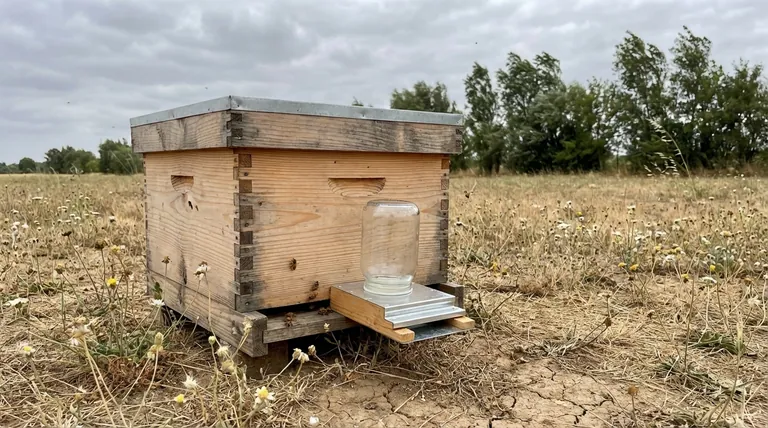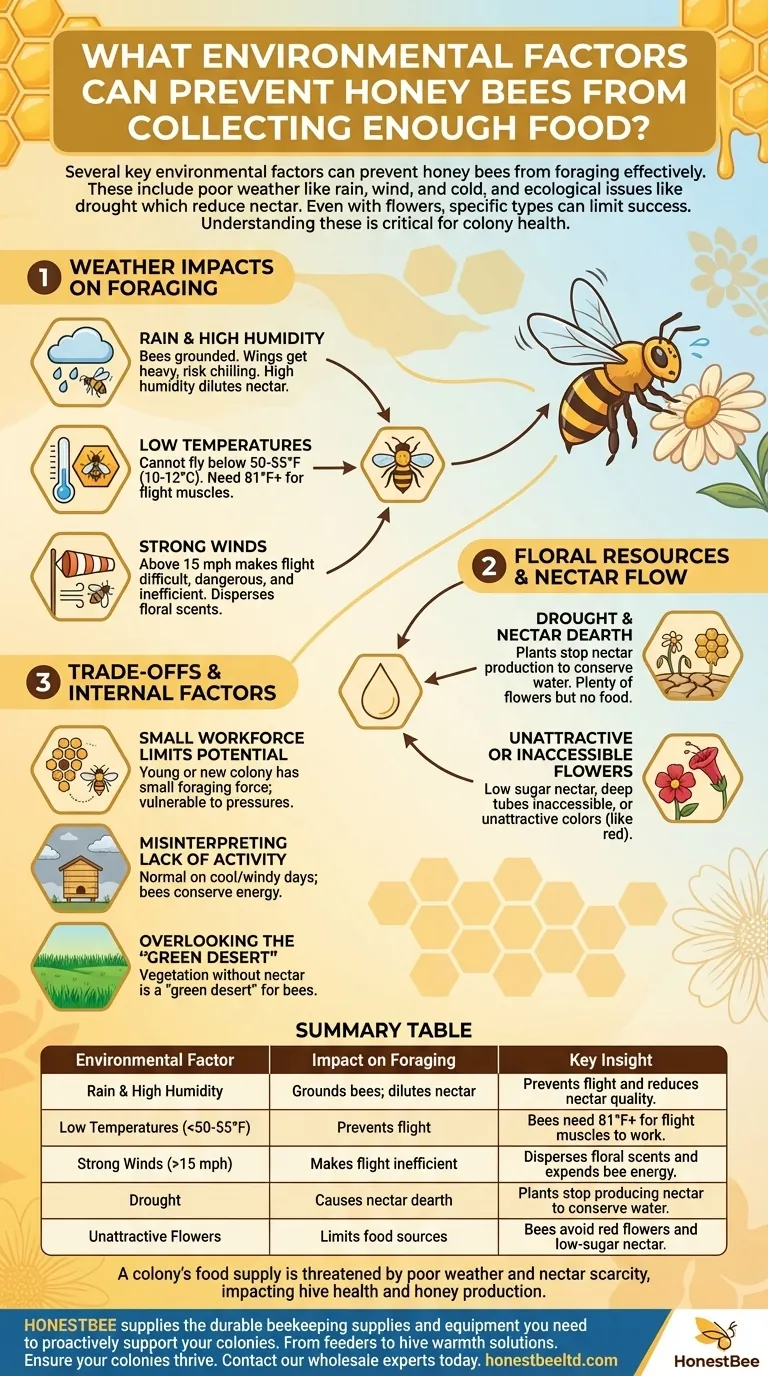In short, several key environmental factors can prevent honey bees from foraging effectively. These include poor weather conditions like rain, strong winds, and cold temperatures, as well as ecological issues such as drought, which reduces the amount of nectar available in flowers. Even when conditions seem ideal, the specific types of flowers available can also limit a colony's success.
A honey bee colony's ability to gather food is a delicate balance between having enough good foraging days and the availability of nectar-rich resources. Understanding these environmental pressures is critical for anticipating food shortages and ensuring the long-term health of the hive.
The Impact of Weather on Foraging Activity
Weather is the most immediate and obvious factor that dictates whether bees can leave the hive. A colony's foraging force can be grounded for days at a time, consuming stored resources without replenishing them.
Rain and High Humidity
Bees cannot fly in the rain. Their wings become wet and heavy, making flight impossible and posing a risk of chilling. Even high humidity can be a deterrent, as it can dilute the nectar in flowers, making it less energetically rewarding to collect.
Low Temperatures
Honey bees are cold-blooded and require a thoracic (flight muscle) temperature of at least 81°F (27°C) to fly. They generally will not forage in temperatures below 50-55°F (10-12°C), as it becomes too difficult to maintain the body heat necessary for flight. On cool mornings, they remain inside, clustered for warmth.
Strong Winds
Winds above 15 mph make flight difficult, dangerous, and inefficient. Bees must expend significantly more energy to fly against the wind, and strong gusts can knock them to the ground. Wind also disperses the floral scents that bees use to locate their food sources.
The Role of Floral Resources and Nectar Flow
The presence of flowers is not enough; the quality and accessibility of the nectar they produce are what truly matter. This is often referred to as the nectar flow.
Drought and Nectar Scarcity
During a drought, plants conserve water by reducing or completely stopping nectar production. This can lead to a period known as a nectar dearth, where there are plenty of flowers but virtually no food available for pollinators. This is one of the most significant environmental threats to a colony's food supply.
Unattractive or Inaccessible Flowers
Not all flowers are created equal. Some plants produce nectar that is low in sugar, while others have physical shapes, such as deep tubes, that prevent honey bees from reaching the nectar with their relatively short tongues. Furthermore, bees perceive colors differently than humans and are not attracted to the color red, which they see as black.
Understanding the Trade-offs and Internal Factors
It's crucial to distinguish between environmental limitations and internal colony issues, as they often interact.
A Small Workforce Limits Potential
A young, small, or newly established colony has a proportionally small foraging force. Even in perfect weather with abundant nectar, it simply does not have the population to gather a large surplus of food. This makes new colonies particularly vulnerable to environmental pressures.
Misinterpreting a Lack of Activity
A common mistake is to assume a quiet hive entrance means the colony is weak or dead. On a cool, windy, or overcast day, it is perfectly normal for the bees to stay inside. A healthy colony knows when to conserve energy and will wait for better conditions.
Overlooking the "Green Desert"
Beekeepers must learn to see the landscape as a bee does. A lush, green lawn or a field of flowers that don't produce nectar is effectively a "green desert." The presence of vegetation does not guarantee the availability of bee-forage.
Making the Right Choice for Your Goal
By understanding these factors, you can better anticipate your colony's needs and provide timely support.
- If your primary focus is navigating bad weather: Be prepared to provide supplemental feeding (sugar water) during extended periods of rain, wind, or cold to prevent the colony from consuming all of its stores.
- If you are concerned about drought or nectar dearth: Plant a diverse and successive bloom of bee-friendly, drought-tolerant flowers and monitor for signs of food stress, such as aggressive behavior at the hive entrance.
- If you are managing a new or small colony: Recognize their limited foraging capacity and provide consistent supplemental feeding until they have built up a strong population with at least 6-8 frames of bees.
By learning to read these environmental cues, you can shift from being a reactive observer to a proactive partner in your colony's success.

Summary Table:
| Environmental Factor | Impact on Foraging | Key Insight |
|---|---|---|
| Rain & High Humidity | Grounds bees; dilutes nectar | Prevents flight and reduces nectar quality. |
| Low Temperatures (<50-55°F) | Prevents flight | Bees need 81°F+ for flight muscles to work. |
| Strong Winds (>15 mph) | Makes flight inefficient | Disperses floral scents and expends bee energy. |
| Drought | Causes nectar dearth | Plants stop producing nectar to conserve water. |
| Unattractive Flowers | Limits food sources | Bees avoid red flowers and low-sugar nectar. |
Is your apiary prepared for environmental challenges?
A honey bee colony's food supply is directly threatened by poor weather and nectar scarcity. For commercial apiaries and distributors, these factors can significantly impact hive health and honey production.
HONESTBEE supplies the durable beekeeping supplies and equipment you need to proactively support your colonies. From feeders for supplemental nutrition during a dearth to equipment that helps maintain hive warmth, we help you navigate environmental pressures.
Ensure your colonies thrive. Contact our wholesale experts today to discuss equipment solutions tailored for commercial beekeeping success.
Visual Guide

Related Products
- Boardman Entrance Bee Feeder Durable Galvanized Steel and Wood Construction for Beekeeping
- HONESTBEE Entrance Bee Feeder Professional Hive Nutrition Solution for Beekeeping
- HONESTBEE Round Hive Top Bee Feeder for Syrup
- Classic Boardman Entrance Bee Feeder Hive Front Feeding Solution
- Professional Hive Front Entrance Bee Feeder
People Also Ask
- How to make an entrance feeder for bees? A DIY Guide for Safe & Effective Feeding
- How do you make an entrance feeder for bees? A Guide to Safe & Effective Hive Feeding
- How does an entrance feeder work? A Guide to Its Simple Mechanics and Risks
- What is an entrance feeder? A Guide to Its Simple Design and High Robbing Risk
- What are the different types of feeders available for beehives? A Guide to Entrance, Hive-Top, and Frame Feeders



















